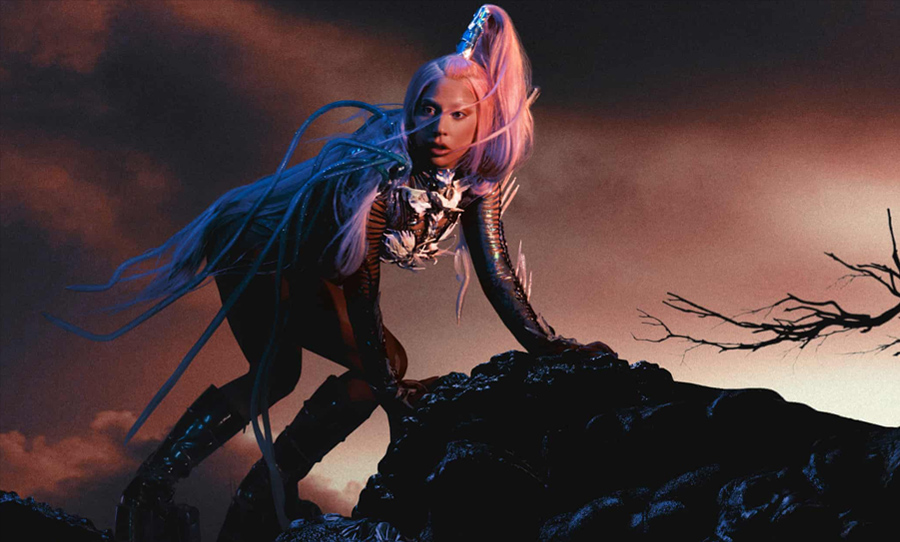On her sixth studio album, Lady Gaga has returned home. Pitched as the hyper-fictionalised utopia of equality, Chromatica delivers the singer back to her Manhattan club scene roots; a colossal legacy, re-invigorated creative vision, and career’s-worth of agony all in tow.
Following the moderate success of 2013’s Artpop, Gaga moulded herself into every possible artistic guise: jazz, country, and musical drama – all as a means to armour herself against the persistent criticism she faced from the music industry. Now, Chromatica is her victory cry. It’s vulnerable, it’s free, and it’s undeniably Gaga.

Self-love is a war that must be fought and won. For some, the battle is uncomplicated, others may never win. However, this conflict runs constantly beneath our lives. On Chromatica, Gaga painfully details the battles endured throughout her career, finding resolution in the very place her project was born: the dance floor.
Throughout her 12-year career, Lady Gaga (real name Stefani Germanotta), has used her unbounded creativity to carve music in every way imaginable. Synth-pop, ’70s piano ballads, ’80s DIY rock, jukebox country, jazz, and ’90s house – the New York-born singer dominated the last decade in a league entirely of her own.
Often likened to a rich niche of chameleonic pop-stars, including influences from the likes of Bowie and Madonna, it didn’t take long before critics connected the singer’s nuanced artistic choices to that of her predecessors. The reputation as a Madonna-copycat has haunted Gaga for years; purported by audiences, industry professionals, and even music icons like Grace Jones. Gaga’s aptitude for artistic versatility would quickly become a tool for reformation.
From 2013 onwards, Germanotta soldiered through genre with modest success. The eclectic Artpop and folk-ballad Joanne were appreciated, however, failed to meet the success of her earlier work. Whilst her cultural influence as a champion of LGBTQI+ visibility transcended this plateau, it appeared that the industry was patiently waiting for her career to fade. It wasn’t until the global triumph of A Star is Born and her smash hit with Bradley Cooper, Shallow, that Gaga finally returned to centre stage.
Shallow’s success could have seen Gaga ride a comfortable career of country-rock ballads, a logical progression from Joanne. Yet, she opted for self-reference. Chromatica can be viewed through two lenses: the cliche, embarking on a journey to find or prove yourself, only to realise that the best version of you was there all along; or the memoir, a raw narrative of the singer’s 12-year crusade for artistic growth, self-love, and most intrinsically, respect. This record is her Eden.
From the album’s prelude, it is clear that the lush beats and synth instincts of dance-pop is where Gaga feels most at ease. Each song bleeds perfectly into the next, crafting a revolving universe of club that overflows with ambition.
“I live on Chromatica, that is where I live,” Gaga stated in a recent radio interview. “I went into my frame. I found Earth, I deleted it. Earth is cancelled. I live on Chromatica.”
Aesthetically, the record feels more a part of the Grimes catalogue, rather than anything Gaga’s ventured before. The formidable, cosmic warrior we find in the Rain On Me music video or the ’90s sci-fi cartoon stylings of Stupid Love feel centuries away from the chic futurism of Bad Romance, but also somehow, cut from the same cloth. It’s empowering to see her regain control of that otherworldly creativity we always knew she had. It’s 2008 the remix, new and improved.
The record is cleanly divided into three competing temperatures; optimism, desolation, and comfort. Much like its namesake 12-note scale, Chromatica cascades around an archetypal narrative structure, allowing audiences to neatly focus on each track. It’s easy to see how this could be a reflection of her career.
Chromatica I ascends with an overpowering infinity. We watch on as Gaga stares across plains of unbounded potential, an anxious delight washes over. This is the beginning of her career; spirited and empowered. Strings shift to crunching bass as Alice begins. “My name isn’t Alice, but I’ll keep looking for Wonderland,” she sings. It is the reach for power, love, and purpose, that we each experience as we enter the world.
As the record continues, our heroine is continually faced by criticism, yet never loses her ambition. The album’s second single Rain on Me, featuring Ariana Grande, stands as the trophy of this perseverance. The densely metaphorical track showers the emerging star with downpours of abuse, however, she simply lets the “water like misery” wash over her. The following songs Free Woman and Fun Night lend themselves directly to this optimism. Chromatica I is the resilience of passion found during the early stages of any career.
Enter Chromatica II, the record’s narrative conflict. As unease curls over the scene, audiences are well aware of what’s to come. Deceptively, Gaga still maintains an upbeat pace to each track, yet details brutal agony within her lyrics. Plastic Doll, Replay, and 911 each address the singer’s struggles with addiction, perfectionism, and trauma. “It’s torturing me, the scars on my mind are on replay,” she sings in Replay. This is the inner-saboteur weakening the singer’s defences against the world. Arguably, Cromatica II could reflect her post-Art-Pop era; sombre and guarded, yet still passionate.
In Chromatica III, we reach a resolution. Following years of pain, and turmoil, Gaga finally comes to rest in a utopia of self-love and determination: Chromatica. Having conquered her personal demons, the tableau unfurls with cinematic grandeur. The singer is bruised yet strong, healing yet resilient. Sine from Above (featuring Elton John), 1000 Doves, and Babylon, each stand for what Gaga has won through her journey. Locating conviction in one’s self is never a straight path, however, Gaga has woven her suffering into a sonnet.
As the record closes, audiences are left submerged in empowerment. Gaga has traced a journey from naïvity to clarity, moulding her darkest insecurities for all to see. As much as Chromatica stands as a rehabilitating catharsis following 12-years of artistic scrutiny, the singer has offered the album to audiences as a beacon of wisdom.
A Shakesperian drama hidden behind glossy electro-pop, she instructs us to trust our intuition, strive for greatness, and make self-love our immediate priority. Setting this ethos against her extraterrestrial visuals is a daring choice, one which could easily distract from her lyrical intent. However, her balance of creativity and heart allows the record’s aesthetics to deepen the flavour of her music. It’s deeply rich symbolic imagery, perfectly suited to the record’s biographic tone.
While Gaga’s career has been anything but consistent, her passion has never faltered. Limitless creativity, an unparalleled drive, and an intrinsic appreciation for art, Gaga outran her critiques a long time ago, and she’s showing no intention of slowing down. In her music and beyond, Gaga has crafted an oasis amongst the chaos, given a voice to the voiceless, inspired audiences to dare, pushed the bounds of creativity, and bared her soul in order to guide others.
Welcome to Chromatica, grab your copy here.


